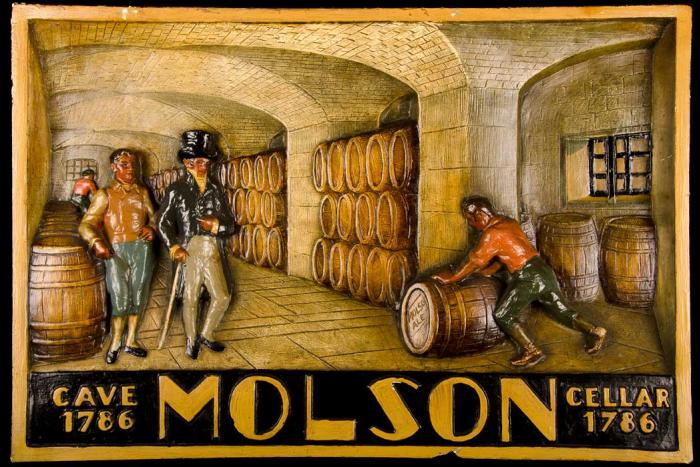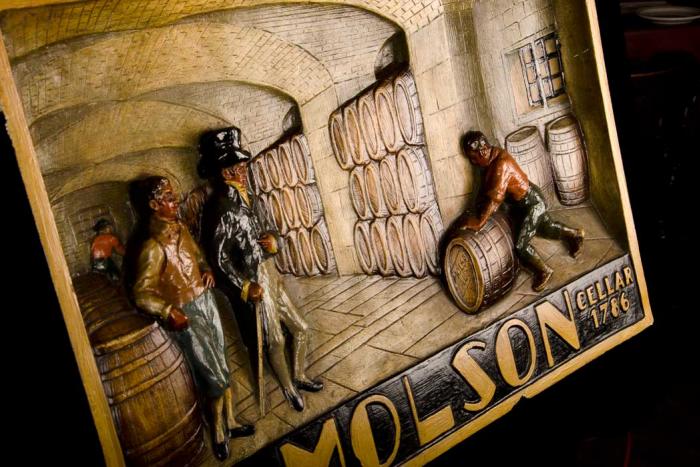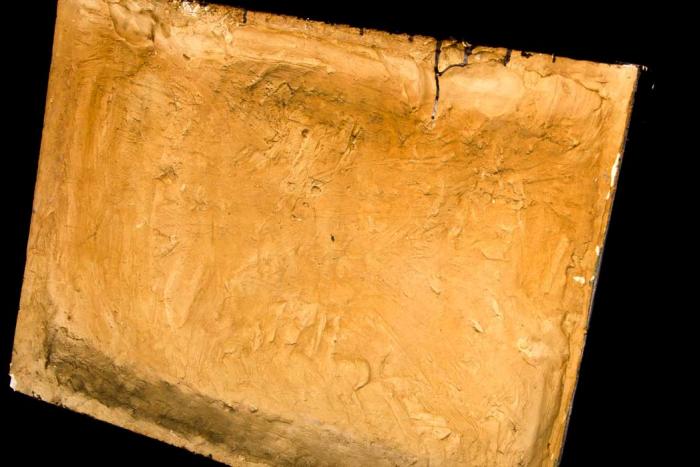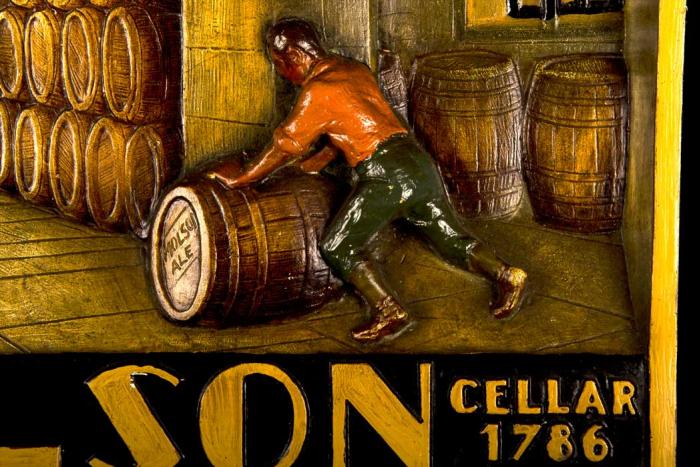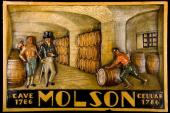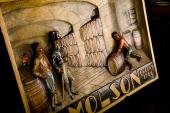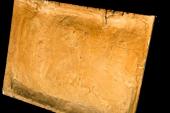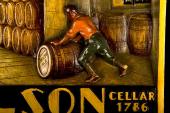Molson Plaque
Organization: Sebby’s Pub and Grill
Coordinates: www.sebbys.com
Address: 83 Queen Street (Lennoxville), Sherbrooke, QC J1M 1J3
Region: Estrie
Contact: Louis S. Pilon (Sebby’s) 819-569-9755; Julie Daoust (Specialist: Records and archives management,
Molson–Coors), julie.daoust(a)molsoncoors.com, www.molsoncoorscanada.com
Description: A large plaster plaque carved in relief and painted, depicting a scene in the
Molson cellar, bearing the words “Cave 1786 MOLSON Cellar 1786”.
Year made: 1936
Made by: One of a series made for Molson’s 150th anniversary, and purchased in the 1990s in an antique shop in Magog, Quebec.
Materials/Medium: Plaster, paint
Colours: Black, orange, yellow, blue, grey
Provenance: Montreal
Size: 70 cm x 49 cm x 6 cm
Photos: Rachel Garber. Courtesy Sebby’s Pub and Grill
“To drink or not to drink?” - That was the Question
Jessica Grosman
Molson Brewery advertisements are found throughout Quebec. Louis Pilon, owner of Sebby’s Pub & Grill in Lennoxville, Quebec purchased a Molson plaque because he wanted a part of Molson’s heritage to decorate the restaurant’s dining room: “I knew it was an original, an antique, something Molson had made.”

The plaque is now situated above the entrance to his kitchen, reminding everyone who walks through the door that Molson is part of Quebec’s past and present, and likely its future too. A company doesn’t reach this level of exposure and familiarity by accident; it’s a long history of the Molson family negotiating and developing a relationship with Quebec.
The Molson Brewery (now known as Molson-Coors Brewing Company Canada) is the second oldest company in Canada next to the Hudson's Bay Company and the oldest brewery in North America. John Molson (1763-1836), a British immigrant, started the Molson Brewery in 1786 when he was only 23 years of age. Seven generations later, the company still operates at its original location in Montreal on the shores of the St. Lawrence River.
John Molson's company quickly became a success, and he reinvested in other business opportunities. The Molson family invested in the lumber industry, Canada’s first railway “The Champlain & St. Lawrence,” steamboats on the St. Lawrence River and the Molson Bank, which later merged with the Bank of Montreal. John Molson and his sons developed Quebec’s economy throughout the 19th century.
The painted plaster Molson plaque depicts John Molson supervising workers rolling beer kegs in a cellar. Until the First World War, Molson beer was sold directly from wooden kegs in the streets or in taverns.
Imagine a tavern in 1918: It’s dark, eerily quiet. According to Quebec law, the windows to the street are covered and no music is played. Customers have to sit at tables and to drink beer from small glasses.
These rules were part of Quebec’s attempt to control how alcohol was sold and consumed.
The temperance movement blamed alcohol for crime, alienation, mental and emotional problems, poverty and the other miseries found in a big industrial city. In Quebec, charities, Protestant groups, and a minority of Catholics lobbied for prohibition, but the movement was weaker than elsewhere in North America. So it was a great surprise when Quebec Premier Lomer Gouin passed a law that prohibited all types of alcohol on February 7, 1918. Molson Brewery would have to close its doors. Molson, along with other breweries and wine importers in Quebec, formed the “Coalition for Moderation.” The Coalition had little time to act--the law to prohibit alcohol would take effect in one year.
The Coalition’s campaign was two-fold. First, they advertised in newspapers to gain support from the working class. The second approach was political: They demanded a referendum on prohibition. The Coalition claimed that Canada had forced Quebec to prohibit alcohol. Even The Gazette wrote, “The Quebec Government should not wait on Ottawa. Now is the time for the legislature to act, in order to preserve both the right of the Province to govern itself and the liberty of its people.” These words echoed arguments from the conscription crisis during the First World War and Joseph-Nadon Francoeur’s speech in the provincial assembly demanding that Quebec become independent.
On April 10, 1919, referendum day, voters lined the streets outside polling stations. They voted overwhelmingly against prohibition - 78% did not want the government to ban alcohol. At polls in Montreal’s working-class neighbourhoods, not one person voted for Prohibition. The few districts that voted for Prohibition were mostly English-speaking and in rural areas, including the Eastern Townships.
The rest of Canada and the United States had prohibited alcohol, so Quebec was the only place north of Mexico where one could manufacture or buy beer. Molson profited immensely during prohibition. Their beer became popular in illegal bars throughout the United States and Canada. Part of the reason that the antique plaque stands in a present-day “public house” in the Eastern Townships is because Molson and the “Coalition for Moderation” led a successful campaign against prohibition in Quebec.
Their considerable business and social influence continued throughout the 20th century. In the 1940s the company became public, which allowed non-Molson family members to invest in the enterprise. In 1955 Molson Brewery expanded to Toronto and in 1957, the family purchased the Montreal Forum and owned the Montreal Canadiens hockey team.
Their philanthropic activities have also been numerous and have included the fact that they donated money to encourage the first female students to study at McGill University, and started the Montreal General Hospital.
Today Molson has an international presence, and family members continue to hold active roles in the company. The Molson name is synonymous with beer, business, hockey and Quebec.
Sources
Gilles Laporte, Molson et le Québec (Montréal: Michel Brulé, 2009).
Shirley Woods, The Molson Saga, 1973-1983 (Toronto: Doubleday Canada, 1983).
Merrill Denison, The Barley and The Stream: The Molson Story (Toronto: McLelland and Stewart, 1955).
To Learn More
Ian Coutts, Brew North: How Canadians Made Beer and Beer Made Canada, 2010.
Karen Molson, The Molsons: Their Lives and Times, 1780-2000, 2001.
Neil Forsyth, The Molsons in Canada: The First 200 Years,Public Archives Canada, 1986.
Numerous photographs of the Molson family and company are in the William Notman Archives at the McCord Museum and available to view online: http://www.mccord-museum.qc.ca
Author
Jessica Grosman is writing her MA history thesis about how pulp and paper workers in the Saguenay region leveraged the media during labour conflicts. Jessica was raised in Pointe-Fortune, Quebec, and now calls Montreal home.


